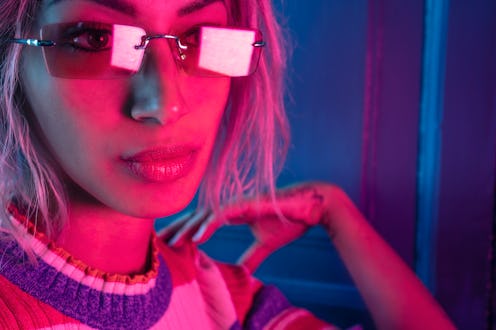(Beauty)
The Truth About Those Blue Light Devices For Your Skin

A few months back, I found myself scrolling through Sephora’s mobile site, considering adding the Lightstim For Acne LED light device to my cart, when a question came to mind: What was the difference between the blue light for skin emitted from this handheld tool (a “therapeutic light energy to treat and control mild to moderate acne,” as Lightstim explains in its product description) and the blue light emitted from my phone screen (which I obsessively block with an Eye Just blue light shield)? Was there a difference? What made one a skincare savior, and the other a skin destroyer? I Googled it — a lot — only to end up even more confused. Half the articles I found praised blue light for its bacteria-killing powers; the other half warned against its tendency to cause inflammation.
I skipped out on the Lightstim, just to be safe, and consulted a dermatologist, who confirmed my suspicions. “Blue light is blue light,” Dr. Eric Bernstein, M.D., a dermatologist and the Director of the Main Line Center for Laser Surgery, tells The Zoe Report. In other words: The blue light coming from your skincare devices and the blue light coming from your electronics are, in fact, one and the same — even though they’re talked about in vastly different ways.
“Blue light is a component of white light that comes from the sun, computer screens, and other light sources,” Dr. Bernstein elaborates. Much has been made about the blue light emitted from phones, laptops, and televisions — it’s a very buzzy topic in the skincare space right now — but in reality, the large majority of blue light exposure comes courtesy of the sun. “The reason it gets so much attention is that blue light is the most energetic visible light, and thus can result in the most biological effects in organs exposed to the sun and other light sources, the skin and the eyes,” the dermatologist says. Those biological effects include inflammation and free radical production, which can result in sun damage. Think: wrinkles, age spots, sagging skin, and even skin cancer.
None of those effects sound pleasant, but here’s the thing: Blue light can also have a positive impact on the skin, if used in the right way. “Just as narrow-band UVB can be used to treat skin conditions such as psoriasis, so can blue light be used to target chemicals in acne bacteria, called porphyrins, to kill acne bacteria and improve acne,” Dr. Berstein says. He maintains that it’s pretty safe “when used at relatively high intensities for very short periods of time,” as is the case with in-office treatments and at-home devices (like the Lightstim). “This is in sharp contrast to passive exposure to blue light over very long periods of time from the sun, with no therapeutic purpose,” he explains.
That doesn’t mean blue light devices are totally risk-free; rather, it means that there are some upsides to blue light treatment that may outweigh the downsides, particularly if you’re prone to cystic acne and scarring and want to tackle bacteria, fast. If your blemishes are few and far between, though, and you’re only interested in a blue light device for the occasional pimple? It’s probably better to skip it.
Additionally, it’s a good idea to protect yourself from passive blue light exposure on the daily with a physical sunscreen that features iron oxides, like Colorescience’s EnviroScreen all-mineral formulation. “Physical blockers not only protect against UV rays, but also have significant ability to block virtually the full solar spectrum,” the dermatologist says. “Iron oxides are effective blue light blockers and protectors.” He also suggests wearing high-quality blue light blocking glasses when out in the sun or staring at a screen (which, basically, is every waking moment, and even some sleeping ones).
Finally, if you’re looking for a new way to treat your acne-prone skin sans blue light, may I suggest a risk-free routine — like manuka honey and meditation, perhaps?
This article was originally published on